Going Meta: Transcendence of Sonata Form in the First Movement of Mahler’s Third Symphony
For some reason, whenever most people think of symphonies, they generally think of their first movements. Some may not even be aware that what they associate with such a massive work only represents the first part of it. But when you think of “dun-dun-dun-duuuuuun” from Beethoven’s Fifth, what are you humming? The first movement. When someone’s cell phone goes off during a concert and you hear the melody from Mozart’s Fortieth, what are you hearing? The first movement. And so forth.
Perhaps this is because many opening movements of larger works are written to entice and excite their audience from the start. Perhaps it is because sonata form (the default choice of form for a symphony’s first movement – more on this later) is such an expansive and enriching way of constructing music that it merits close listening and extensive analysis. Or maybe it’s just because it’s the first thing people hear, and they either doze off or stop listening shortly thereafter.
I like to think the second reason is the most compelling, or at least that is why I tend to be drawn towards these movements. Even though most composers use the same form for their symphonies’ opening movements, the manipulation and evolution of sonata form meant that not only did it not grow stale, it allowed for boundless creativity. My favorite example of this occurs in the first movement of Mahler’s Third Symphony – its structure is rooted in sonata form, but there is clearly something distinct and even more significant happening on the global level of the work’s construction.
First, a word about sonata form. At its core, sonata form is a three-part global structure in which the bulk of the first section (“exposition”) returns at the end (“recapitulation”) with some modifications, while the middle section (“development”) is a creative reimagining of the exposition’s main ideas. On a slightly more local scale, the exposition contains two distinct themes (“primary” and “secondary themes”). The primary theme is stated in the movement’s tonic (main key) in both the exposition and recapitulation, while the secondary theme only appears in tonic in the recapitulation. During the exposition it is heard in a different yet closely-related key, typically in the dominant key to the movement’s tonic. This is what is referred to as the sonata principle – everything that is presented in the exposition must return in the recapitulation in the tonic key.
Like nearly all other symphonic opening movements, the first movement of Mahler’s Third employs sonata form. However, it is used in only the most abstract sense. Mahler has transcended conventional sonata form by masking it within an even more prevalent global form: an evolving binary form that pits two contrasting ideas against one another and creates dual trajectories in which one section’s demise gives way to the other’s triumph.
There are undoubtedly major obstacles for analyzing this movement in terms of conventional sonata form. This is largely due to the weight given to the significant musical blocks, the way in which these interact, as well as the use of repetition throughout. The most obvious structural repetition occurs with the horn call heard at the very beginning and its return at rehearsal number 55 in the score (Ex. 1), as these are ver batim repetitions of one another. A return of material from the very beginning at this point in the piece implies that these moments depict the starts of the exposition and recapitulation sections, but there are too many other discrepancies with the typical function of these sections to lend this analysis much credence.
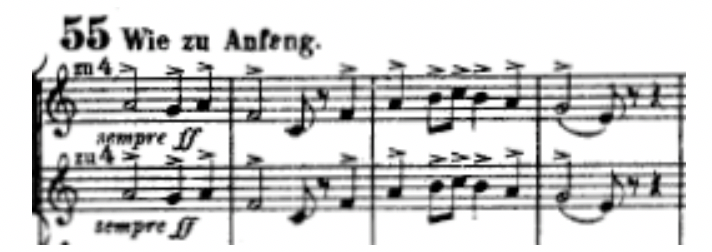
(Ex. 1 – 22:58 in the provided YouTube clip)
Both the exposition and recapitulation require two distinct and contrasting themes, and while the radically unique material that emerges at rehearsal number 11 (Ex. 2) serves this function, the size of the music that precedes this is far too great to be considered a conventional primary theme. And while there is also a transitional section that connects the primary and secondary themes of the exposition, there are too many independent themes within these first five minutes to be analyzed in the capacity of these sections.

(Ex. 2 [flute/violins] – 5:20)
Constantin Floros – a renowned musicologist and Mahler expert – analyzed this movement under the guise of sonata form with a different interpretation. Instead of labeling the beginning as the exposition, he sees this as an extended introduction (272 measures, to be exact). According to his analysis, the exposition does not appear until measure 273 (Ex. 3) with the emergence of a brand new theme. The development section then emerges at measure 369 with the recapitulation starting at the opening horn call’s return in measure 643 (Ex. 1).

(Ex. 3 – 10:51)
What makes this interpretation interesting is that it effectively satisfies the main criteria for an exposition, which was one of the issues with seeing the very beginning as the start of this section. If the horn melody at rehearsal number 23 is the primary theme, then the melody in the low strings at rehearsal number 28 (Ex. 4), while not radically different (especially in regard to rhythm), could be seen as the secondary theme. The key areas of these two moments – F and D major, respectively – also support this analysis. While they do not share the standard relationship of tonic and dominant, the fact that these are arguably the two most significant key areas in the piece compensates for this discrepancy.
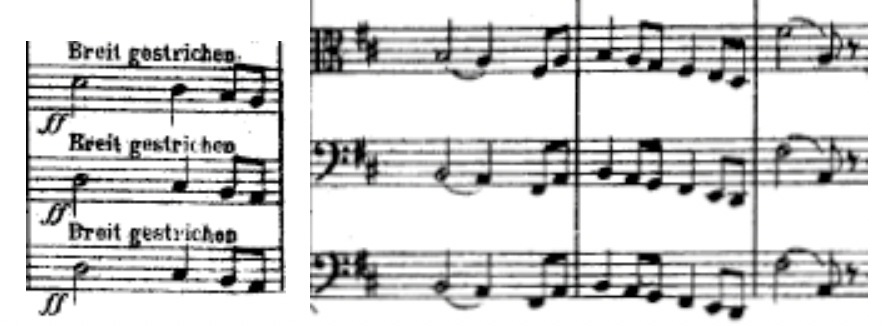
(Ex. 4 – 13:21)
This analysis is not without scrutiny, however. If the aforementioned moments are the two themes of the exposition, their correlating themes in the recapitulation do not match up. The material at rehearsal number 55 is taken from the beginning, and it also maintains its D minor tonality. It is certainly significant that the material originally heard at rehearsal number 28 returns at rehearsal number 73 (Ex. 5) in the key of F major (instead of D major), but the bulk of this final section is too dense and cluttered with far too many themes presented in other parts of the movement to merit a strong connection with this interpretation’s exposition. I also take issue with analyzing the first 272 measures as one large extended introduction, especially with the amount of important themes introduced here that reemerge later. It feels a bit like Floros is trying to sweep this material under the rug.
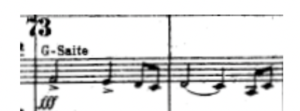
(Ex. 5 [violin, in treble clef] – 31:36)
Instead of trying to squeeze this movement’s square peg into the round hole of sonata form, a more logical and telling understanding of the global form emerges when the movement is perceived as a sequence of alternating structural blocks of extremely contrasting materials. These sections occur in tandem a total of four times, and as unique as each is to its counterpart, the amount of shared material and recognizable connections within either group is even greater. That is to say, there is no disputing that all of the odd numbered sections are related, as are the evens to themselves. The dark, foreboding quality of the very beginning persists in various forms when this material returns, and the brighter, march-like sounds are shared by each of these sections.
This understanding of the global form is supported by Mahler’s early insights towards a programmatic framework that was ultimately abandoned (or, at least, was something Mahler refused to acknowledge publicly). Early drafts of the movement include descriptive headings such as “Pan Awakens: Summer Marches In” for the movement as a whole and “Pan is sleeping” for a passage that occurs about halfway through. Pan is the Greek God of pasture, and he is often associated with spring. Interestingly, he is only one of two Greek Gods who is also dead. In this light, the two main sections can be seen as winter, slumber, or even death being pitted against summer, vibrancy, and life. The semantics of any program Mahler may have intended here is not that important. What is significant, however, is that Mahler clearly had these two distinct sections in mind, and the interaction and development of them in relation to themselves and to their counterparts is essential to understanding the movement.
Below is a chart that illustrates the proportions of each of the four groups of contrasting structural units, with the large numbers referring to total measures within each section and the parenthetical numbers in the box next to them referring to their location in time of the provided YouTube track and the total time of that section, respectively. The more ominous sections (referred to as “Winter”) are on the left, while the march-like sections (“Summer”) are on the right:
| Winter |
Summer |
||||
131 |
(0:00; 5:20) |
||||
|
(5:20; 1:09)
|
32 |
||||
81 |
(6:29; 2:49) |
||||
(9:18; 4:49) |
144 |
||||
81 |
(14:07; 3:05) |
||||
(17:12; 5:46) |
193 |
||||
94 |
(22:58; 4:56) |
||||
|
(27:54; 4:43) |
139 |
What stands out from this is that, up until the final pair of sections, the Winter sections generally decline in weight from the first section, while the Summer sections increase. When Mahler described this movement as “summer prevailing over an overconfident and easily overthrown winter,” he appeared to have the large-scale form in mind. Specifically, this indicates that these contrasting sections not only exist beside one another, they are also being informed and affected by that which precedes them. Not only does the significance of the Winter sections wane throughout the movement, it does so at the expense of Summer’s ascension to prominence.
This interplay can be seen on more local levels, as well. Both sections have themes, gestures, and general musical colors that are specific to them, but some of these traits are picked up and developed in subsequent segments of the contrasting section. For example, the first Winter section concludes with a series of rhythmic calls on the timpani (Ex. 6). A similar figure is used to transition out of the first Summer section, but it is now heard in the bass drum (Ex. 7). This subtle timbral shift creates an immediate point of connection for the listener between these otherwise very different sections.

(Ex. 6 – 5:12)

(Ex. 7 – 6:16)
Another gesture that appears across multiple sections is the harmonic tapestry created by the sustained flute pads and the quivering tremolos in the violins at the beginning of the first Summer section (Ex. 2). In the Winter section that immediately follows, a similar texture has been transported to the clarinets in support of the luscious trombone melody that appeared in the previous section of Winter (Ex. 8). What was originally used as an identifiable foreground gesture has now transformed into a supporting background color, which creates a very enriched connection between the two sections.
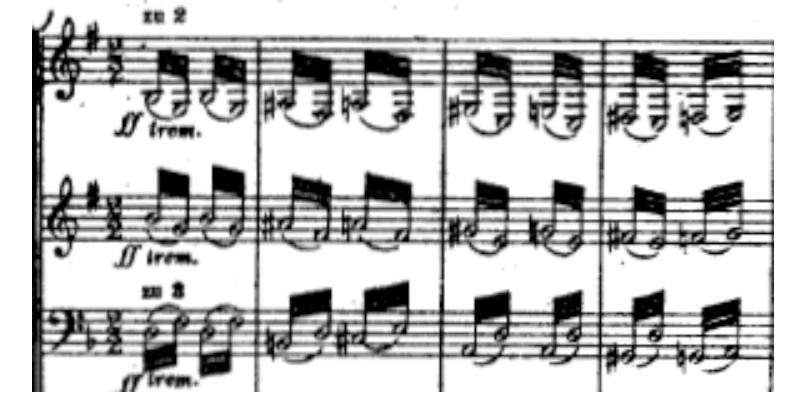 (Ex. 8 – 7:00)
(Ex. 8 – 7:00)
One of the simplest yet most discernable motives throughout the first movement is the rapid trumpet arpeggio, which appears for the first time at 1:35 in the accompanying recording. Perhaps because of its brevity, this gesture proves to be one of the most malleable ones, especially throughout the contrasting Summer sections. Elements of this motive can be detected in several melodies later on, including the violin melody in the second Summer section at rehearsal number 20 (Ex. 9), the woodwind/viola melody also in this section at rehearsal number 27 (Ex. 10), and the horn melody in the third Summer section at rehearsal number 51 (Ex. 11). This gesture is also integral to the colorful oboe turns (Ex. 12), as they both possess the same rhythmic quality of three very short notes followed by a sustained note.

(Ex. 9 – 10:00)

(Ex. 10 – 12:43)
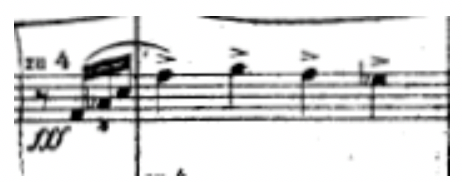
(Ex. 11 – 22:03)
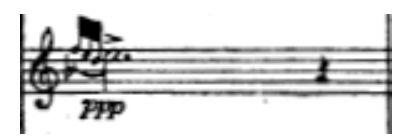
(Ex. 12 – 10:00)
Some of the most important melodic themes are also developed throughout contrasting sections. The very first sounds of the gargantuan movement – and possibly the most identifiable theme – are that unaccompanied horn melody that boldly establishes both the tonality and mood of the Winter sections. As integral as this melody is to Winter, even it is not immune to annexation from Summer. In fact, it plays a key role in establishing arguably the most significant theme of Summer. The horn melody that is introduced at rehearsal number 23 (the start of the exposition according to Floros’ analysis; Ex. 3) is used in the most climactic moments throughout the four Summer sections, yet it borrows heavily from the original horn melody. While it is in a completely different tonality, the rhythmic structure and intervallic content is strikingly similar.
Speaking of tonality, the use of key areas in different sections provides a more abstract means of observing the interactions of Winter and Summer. Although Mahler employs a substantial network of key areas throughout, the most important tonalities are D minor for Winter sections and Db major for Summer. There are two departures from these conventions that stand out in an interpretation of the movement as containing dual trajectories: the sudden switch to D major to conclude the final Winter section (cadence demonstrated in Ex. 13), and the predominant use of F major in the final Summer section (Ex. 14).
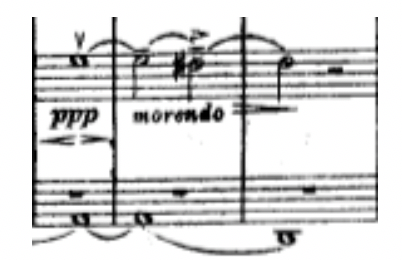
(Ex. 13 [cello/double bass] – 27:40)

(Ex. 14 – 28:48)
The former is significant because this is the first substantial use of a major key throughout the Winter sections, and it also represents the final cadence heard for Winter. This not only provides the listener with an unexpected lasting impression of these sections, it depicts a resignation of Winter at the hands of Summer. The conclusion of the previous Winter section supports this analysis. Both share similar trombone melodies that turn suddenly from minor to major (rehearsal number 33 for the earlier instance), but the former ultimately resolves back to D minor before giving way to the next section of Summer. It is as if the final deathblow has been delivered to Winter at the end, and Summer is able to conclude the movement triumphantly.
That latter modulation maintains Summer’s established major mode, but the use of F major portrays a large-scale resolution of Winter’s D minor. A journey from D minor to its relative major would not be uncommon in any piece, but it is somewhat masked here by the fact that it plays out on a meta-level. Although this also ties in with the movement’s abstract use of sonata form (F major was used in the second Summer section, but all themes appear in F major during the final section), the more meaningful interpretation seems to be that this ultimately mediates and satisfies the conflict between Winter and Summer, with Summer emerging as doubly victorious.
Because of Mahler’s avoidance of discussing programmatic elements in his Third Symphony, I hesitate to get too enamored in using descriptive terminology, and I mainly use “Winter” and “Summer” (words Mahler used himself) as a convenient way of identifying the two contrasting sections. Regardless of these semantics, Mahler has clearly transcended conventional sonata form in this first movement by pitting two distinct yet equally vibrant sections against one another. Furthermore, these two do not exist in a vacuum, as one perpetually informs the other throughout their musical dialogue. And while I love the individual themes sprinkled throughout the movement (The angular horn/trombone melody that appears throughout the Winter sections? Purely sublime.), nothing keeps bringing me back to this brilliant work like Mahler’s masterfully crafted way of letting the form be more than just a way to organize his thoughts.
